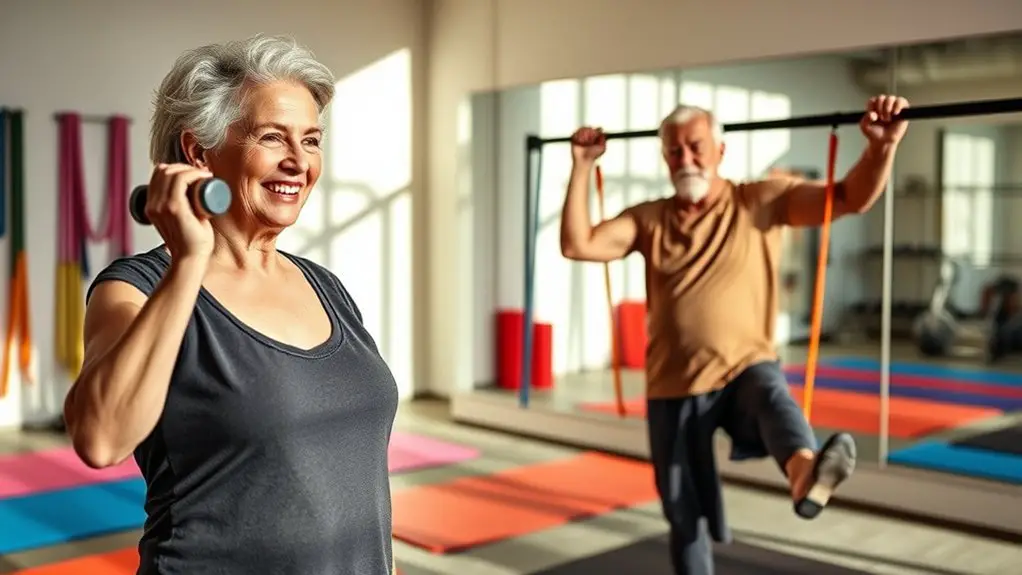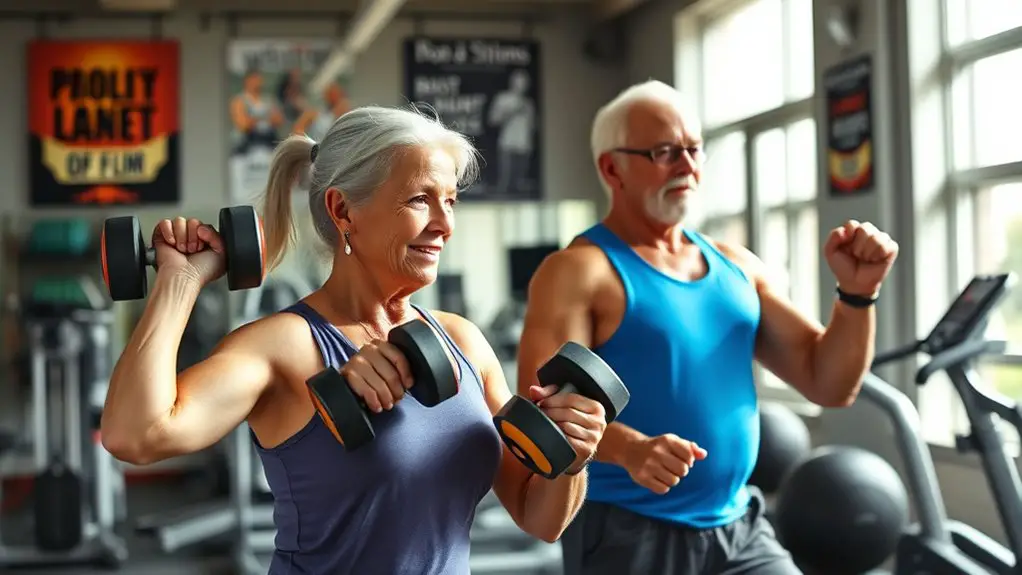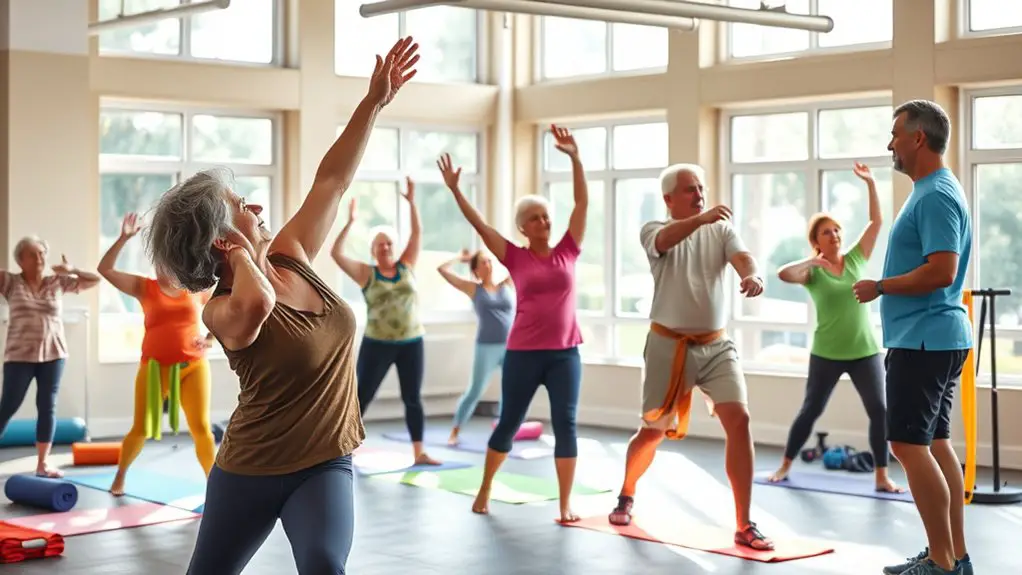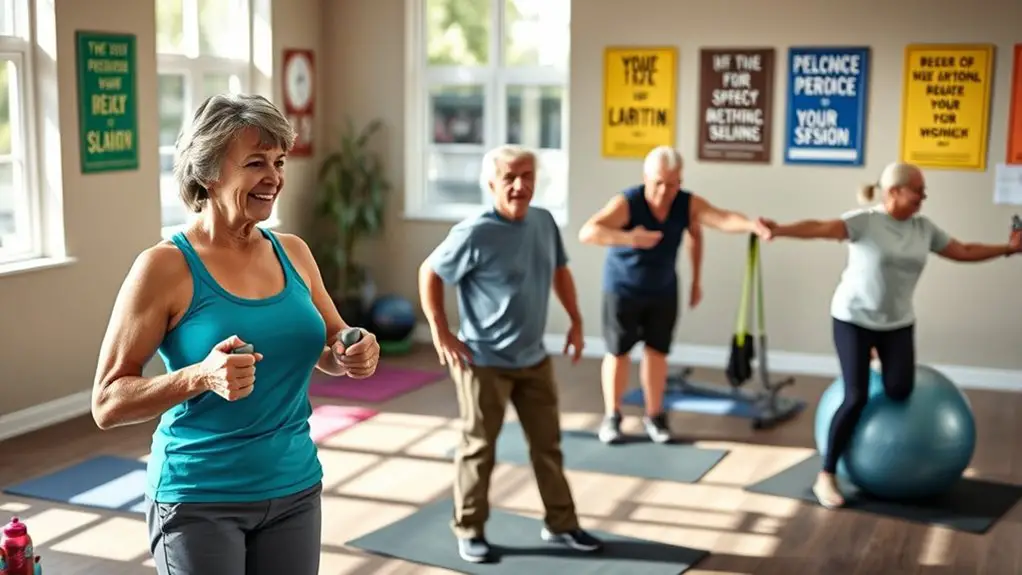How Gym Training Helps Seniors Stay Mobile and Strong

Gym training helps you stay mobile and strong by enhancing your muscle strength, balance, and flexibility. As you engage in strength exercises, you counteract age-related muscle loss, making daily activities easier. Balance and coordination workouts reduce fall risks, while flexibility training boosts your range of motion and helps prevent injuries. Plus, regular gym visits can uplift your mood and improve mental health. Discover how to create a safe and effective workout routine tailored just for you.
The Importance of Strength Training for Seniors

As you age, maintaining strength becomes essential for your overall health and well-being. Strength training isn’t just about lifting heavy weights; it’s crucial for muscle preservation and enhancing your functional strength. By engaging in regular strength exercises, you can counteract the natural decline in muscle mass that occurs with aging. This isn’t just about looking good; it’s about staying active and independent.
Building functional strength allows you to perform daily activities with ease, from carrying groceries to climbing stairs. You’ll find that a consistent gym routine can boost your energy levels, improve your mood, and even enhance your cognitive function. Remember, it’s never too late to start! Incorporating strength training into your weekly schedule can lead to significant improvements in your quality of life. Visible improvements in body composition can also motivate you to maintain your fitness journey. So, take that first step and embrace the power of strength training—it’s a game-changer for your health!
Enhancing Balance and Coordination Through Exercise
While you might not think of exercise as a tool for balance, incorporating specific movements into your routine can greatly enhance your stability and coordination. Balance exercises and coordination drills are essential for maintaining independence as you age. They not only help prevent falls but also improve your overall mobility.
Here’s a quick reference table for some effective exercises:
| Balance Exercises | Coordination Drills |
|---|---|
| Single-leg stands | Heel-to-toe walk |
| Tai Chi | Ball toss |
| Standing on one foot | Side-to-side leg lifts |
Building Flexibility to Prevent Injuries

Incorporating flexibility training into your workout routine is vital for preventing injuries, especially as you age. By focusing on dynamic stretching and mobility exercises, you can enhance your overall flexibility and keep your body functioning at its best. Here are four key benefits to take into account:
- Increased Range of Motion: Flexibility allows you to move more freely, which is essential for daily activities.
- Improved Posture: Regular stretching helps maintain proper alignment, reducing the risk of strain or injury.
- Enhanced Muscle Performance: Flexible muscles perform better, which translates to improved strength and endurance during workouts.
- Quicker Recovery: Staying flexible can help your muscles recover faster after exercise, minimizing soreness.
The Mental Health Benefits of Regular Gym Training
When you hit the gym regularly, you’re not just working on your physical strength; you’re also boosting your mental health. Exercise is a powerful tool for enhancing cognitive function, helping you stay sharp and focused. By engaging in gym training, you stimulate the release of endorphins, those feel-good hormones that elevate your mood and combat feelings of anxiety and depression.
Moreover, regular workouts provide a structured routine, which can be incredibly beneficial for your mental well-being. This routine fosters a sense of accomplishment and purpose, reducing stress levels in your daily life. You’ll likely find that even minor achievements at the gym can lift your spirits and motivate you to tackle challenges outside the gym.
Creating a Safe and Effective Workout Routine for Seniors

Maintaining mental well-being through gym training sets a strong foundation for developing a safe and effective workout routine tailored specifically for seniors. To create a personalized program that meets your needs, consider these key elements:
- Start Slow: Begin with low impact exercises, allowing your body to adapt to the new routine.
- Focus on Balance: Incorporate activities that improve stability, such as tai chi or simple balance drills.
- Strength Training: Use light weights or resistance bands to build muscle strength without overexertion.
- Listen to Your Body: Pay attention to how you feel during and after workouts, adjusting intensity as needed.
Frequently Asked Questions
What Types of Gym Equipment Are Safe for Seniors?
When considering gym equipment that’s safe for seniors, resistance bands and stability balls are great options. Resistance bands offer adjustable tension, making them perfect for strength training without the strain of heavy weights. They’re lightweight and easy to use. Stability balls enhance balance and core strength, providing a secure way to engage muscles. Incorporating these tools into your routine can help you stay active and confident, ensuring you enjoy your workouts safely and effectively.
How Often Should Seniors Work Out Each Week?
You should aim for a fitness frequency of at least 150 minutes of moderate aerobic activity each week, spread over several days. Incorporating strength training at least twice a week can enhance your weekly routine. It’s important to listen to your body and adjust as needed. Staying consistent not only boosts your physical health but also uplifts your mood and energy levels. So, make those workouts a priority – you’ll feel the benefits!
Can Seniors Benefit From Group Fitness Classes?
Absolutely, you can benefit immensely from group fitness classes! Imagine enjoying social interaction, feeling the energy of others, and sharing fitness motivation. These classes not only keep you active but also foster friendships and a supportive community. Engaging in group workouts can boost your confidence, help you stay committed, and make exercising fun. So, grab a friend or join a class and embrace the positive vibes that come with working out together!
What Should Seniors Eat to Support Their Training?
To support your training, focus on incorporating lean protein sources like chicken, fish, beans, and nuts into your meals. Meal timing is essential too; try to eat a balanced meal or snack rich in protein within an hour after your workout. This can help with recovery and muscle maintenance. Remember, staying hydrated is just as important, so drink plenty of water throughout the day to keep your energy levels up and your body functioning well.
How Can Seniors Track Their Fitness Progress Effectively?
Tracking your fitness progress is essential to staying motivated and seeing results. You can use fitness journals to jot down your workouts, noting reps, sets, and how you feel. Alternatively, progress apps can simplify this process, allowing you to log activities and monitor improvements over time. Whichever method you choose, consistently recording your efforts will help you celebrate milestones and stay committed to your fitness journey. You’ve got this!





